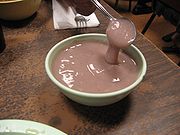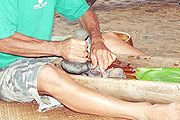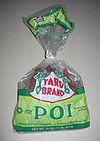
Poi (food)
Encyclopedia

Hawaiian language
The Hawaiian language is a Polynesian language that takes its name from Hawaii, the largest island in the tropical North Pacific archipelago where it developed. Hawaiian, along with English, is an official language of the state of Hawaii...
word for the primary Polynesia
Polynesia
Polynesia is a subregion of Oceania, made up of over 1,000 islands scattered over the central and southern Pacific Ocean. The indigenous people who inhabit the islands of Polynesia are termed Polynesians and they share many similar traits including language, culture and beliefs...
n staple food
Staple food
A staple food is one that is eaten regularly and in such quantities that it constitutes a dominant portion of a diet, and that supplies a high proportion of energy and nutrient needs. Most people live on a diet based on one or more staples...
made from the corm
Corm
A corm is a short, vertical, swollen underground plant stem that serves as a storage organ used by some plants to survive winter or other adverse conditions such as summer drought and heat ....
of the taro
Taro
Taro is a common name for the corms and tubers of several plants in the family Araceae . Of these, Colocasia esculenta is the most widely cultivated, and is the subject of this article. More specifically, this article describes the 'dasheen' form of taro; another variety is called eddoe.Taro is...
plant (known in Hawaiian as ). Poi is produced by mashing the cooked corm (baked or steamed) until it is a highly viscous fluid. Water is added during mashing and again just before eating, to achieve a desired consistency, which can range from liquid to dough-like (poi can be known as two-finger or three-finger, alluding to how many fingers you would have to use to eat it, depending on its consistency).
Poi made from Taro should not be confused with
- SamoaSamoaSamoa , officially the Independent State of Samoa, formerly known as Western Samoa is a country encompassing the western part of the Samoan Islands in the South Pacific Ocean. It became independent from New Zealand in 1962. The two main islands of Samoa are Upolu and one of the biggest islands in...
n poi, which is a creamy dessert created by mashing ripe bananas with coconut cream. - TahitiTahitiTahiti is the largest island in the Windward group of French Polynesia, located in the archipelago of the Society Islands in the southern Pacific Ocean. It is the economic, cultural and political centre of French Polynesia. The island was formed from volcanic activity and is high and mountainous...
an po'ePo'ePoe is a popular dish in Tahiti, where it is frequently eaten as a dessert, although it can also be served along with other dishes at a traditional tamaraa or feast. It is a sweet, pudding-like confection made from bananas, papaya, or mangoes cooked with manioc and coconut cream...
, which is a sweet, pudding-like dish made with bananaBananaBanana is the common name for herbaceous plants of the genus Musa and for the fruit they produce. Bananas come in a variety of sizes and colors when ripe, including yellow, purple, and red....
s, papayaPapayaThe papaya , papaw, or pawpaw is the fruit of the plant Carica papaya, the sole species in the genus Carica of the plant family Caricaceae...
, or mangoMangoThe mango is a fleshy stone fruit belonging to the genus Mangifera, consisting of numerous tropical fruiting trees in the flowering plant family Anacardiaceae. The mango is native to India from where it spread all over the world. It is also the most cultivated fruit of the tropical world. While...
es cooked with manioc and coconutCoconutThe coconut palm, Cocos nucifera, is a member of the family Arecaceae . It is the only accepted species in the genus Cocos. The term coconut can refer to the entire coconut palm, the seed, or the fruit, which is not a botanical nut. The spelling cocoanut is an old-fashioned form of the word...
cream.
History and culture

Shortages in taro production in recent years due to pests and labor shortages have also resulted in shortages and higher prices for poi in Hawaii. At the same time, innovations in poi production have resulted in poi that stays fresh longer and tastes sweeter, but such products generally sell at a premium price and require refrigeration.
Food

Fermentation (food)
Fermentation in food processing typically is the conversion of carbohydrates to alcohols and carbon dioxide or organic acids using yeasts, bacteria, or a combination thereof, under anaerobic conditions. Fermentation in simple terms is the chemical conversion of sugars into ethanol...
process depends upon the bacteria level in the poi. To slow the souring process, poi should be stored in a cool, dark location (such as a kitchen cupboard). Poi stored in the refrigerator should be squeezed out of the bag into a bowl, and a thin layer of water drizzled over the top to keep a crust from forming.
Poi is a natural laxative, so it is best to avoid eating it in large quantities.
Sour poi is still quite edible with salted fish or lomi salmon
Lomi salmon
Lomi salmon is a side dish in Pacific island cuisine. It is a fresh tomato and salmon salad, and was introduced to Hawaiians by early western sailors...
on the side. Sourness is prevented by freezing or dehydrating, although the resulting poi tends to be bland in comparison with the fresh product. For best thawing results place in a microwave with a layer of tap water over the surface of the frozen poi. Sour poi is also used as a cooking ingredient, usually in breads and rolls. It has a smooth, creamy mouthfeel
Mouthfeel
Mouthfeel is a product's physical and chemical interaction in the mouth, an aspect of food rheology. It is a concept used in many areas related to the testing and evaluating of foodstuffs, such as wine-tasting and rheology. It is evaluated from initial perception on the palate, to first bite,...
.
Other uses
Poi has been used as a milk substituteMilk substitute
A milk substitute is a liquid that replaces milk in a diet or recipe. This overlaps with but is distinct from the group of milk-like liquids called "milks" because of their similarity to the liquid produced by mammary glands....
for babies born with an allergy to dairy products
Milk allergy
A milk allergy is a food allergy, an adverse immune reaction to one or more of the constituents of milk from any animal...
because of its nutritional value. It is also used as a baby food
Baby food
Baby food is any food, other than breastmilk or infant formula, that is made specifically for infants, roughly between the ages of four to six months to 2 years. The food comes in multiple varieties and tastes, can be produced by many manufacturers, or may be table food that the rest of the family...
for babies with severe food allergies.
External links
- The History of Poi
- "Powered By Poi" Maui No Ka 'Oi MagazineMaui No Ka 'Oi MagazineMaui Nō Ka Oi Magazine is a bi-monthly regional magazine published by the Haynes Publishing Group in Wailuku, Hawaii.The phrase Maui nō ka ʻoi means "Maui is unparallel" in the Hawaiian language. Maui Nō Ka Oi Magazine features stories relating to the culture, art, dining, environmental issues,...
Vol.11 No.4 (July 2007). - "Kipahulu Kitchen" Article about community commercial kitchen in Kipahulu, MauiMauiThe island of Maui is the second-largest of the Hawaiian Islands at and is the 17th largest island in the United States. Maui is part of the state of Hawaii and is the largest of Maui County's four islands, bigger than Lānai, Kahoolawe, and Molokai. In 2010, Maui had a population of 144,444,...
, where poi is made. Maui No Ka 'Oi MagazineMaui No Ka 'Oi MagazineMaui Nō Ka Oi Magazine is a bi-monthly regional magazine published by the Haynes Publishing Group in Wailuku, Hawaii.The phrase Maui nō ka ʻoi means "Maui is unparallel" in the Hawaiian language. Maui Nō Ka Oi Magazine features stories relating to the culture, art, dining, environmental issues,...
Vol.10 No.2 (April 2006).

